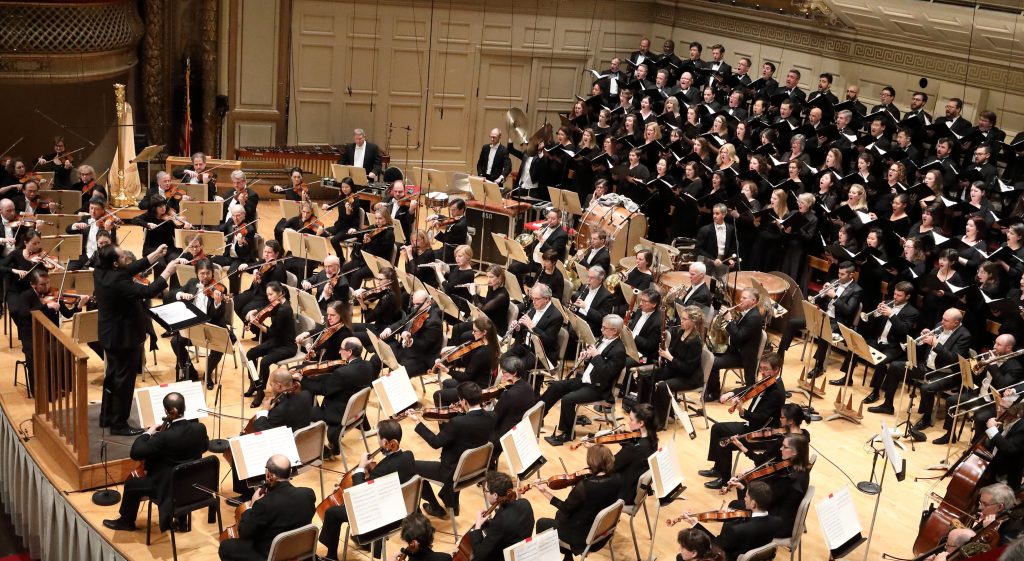Nelsons, BSO hit a Shostakovich speed bump with tub-thumping Second

“October, the Commune, and Lenin” — with those words ends Dmitri Shostakovich’s Symphony No. 2, To October. This concert rarity came to Symphony Hall for the first time ever Thursday night as part of the Boston Symphony Orchestra’s complete survey of the Shostakovich symphonies, with Andris Nelsons conducting.
Written in 1927 to mark the tenth anniversary of the October Revolution and to celebrate the cult of Lenin, the Second is at once Shostakovich’s shortest symphony and his most experimental – as well as his most convoluted and overtly propagandistic.
Lasting around twenty minutes, the score consists of two large parts. The first is instrumental and culminates in a dizzying tapestry of thirteen independent melodic lines. In the second, there’s a setting of an execrable poem by Alexander Bezymensky extolling the glories of the Soviet Union’s founder.
Shostakovich evidently thought little of Bezymensky’s verse – that closing peroration is actually shouted, not sung – and not much more of his own music, ultimately ranking the Symphony among his “creative failures.” Regardless, To October has some striking qualities.
Shostakovich’s handling of the orchestra, for one, is always colorful (the scoring includes a factory siren). Harmonically, his writing is often gritty and freely dissonant. The Second is also wildly virtuosic and free in its approach to rhythmic complexity, which can prove daunting for even the best ensembles.
Such was the case at times on Thursday night. The BSO played the Second’s murky opening bars with a glassy sheen and Thomas Rolfs’ trumpet solos easily floated over the gloomy textures. But the symphony’s extended quiet sections were rhythmically insecure, as demonstrated by the tentative entrances (concertmaster Tamara Smirnova’s solo excepted) during the first half of the fugal section.
Granted, when things got loud and turned more assertive, the BSO played with commensurate freedom and authority. The climaxes of both parts roared. Over the second part’s instrumental peroration, colors blazed and good balances reigned. The Tanglewood Festival Chorus sang splendidly, with robust tone and biting energy. Their concluding three cheers for Lenin were a sonic thrill.
Still, the Second — even without its agitprop texts — doesn’t run deep. On Thursday it came off as little more than bombastic pap.
More successful was Galina Grigorjeva’s On Leaving, which preceded the Shostakovich and contrasted it in tone, mood, and content. Originally written for an instrumental ensemble in 1999, but later reworked as a vocal composition (with flute and percussion accompanying one movement), On Leaving is a five-movement meditation on death that utilizes various texts from the Russian Orthodox liturgy.
On Thursday, Tanglewood conductor James Burton led a well-blended, cogent account of the piece. The outer movements were rich-toned and flowing, while the third (for mens’ voices alone) was dark and somber and the fourth (sans basses) floated. Tenor Matthew Anderson’s dusky second-movement solos potently offset Elizabeth Ostling’s agile execution of the silver-toned flute part.
More contrasts – of tempo, phrasing, dynamics – marked Daniel Lozakovich’s reading of the night’s biggest work, Tchaikovsky’s Violin Concerto. Just eighteen, Lozakovich is an undeniably talented and charismatic fiddler. While his projection Thursday was sometimes forced, he generally played with singing tone, exemplary bow control, impeccable intonation, and a strong sense of musical character (especially in the cadenza and last movement).
Even so, his interpretation has room to grow. The Concerto’s first-movement lyrical sequences, for instance, were all broadened out, sometimes to the point of caricature. Lozakovich brought little sense of spontaneity or shape to these songful reveries, despite their slower tempos, He played the bravura figurations with plenty of zest, but transitions were abrupt and the movement’s structure came across in choppy paragraphs.
Additionally, in the second movement, Lozakovich followed Anne-Sophie Mutter’s self-indulgent habit of drawing out the tempo and taking Tchaikovsky’s lowest dynamic markings down another level or two — gestures that put a strain on the natural flow of the musical line. Only in the finale, with its muscular opening and nimbly dancing refrain, did the solo part consistently come to life.
Nelsons seemed perfectly content to go along with (or at least not rein in) Lozakovich’s excesses. The result, predictably, ranged from episodic and ragged to magical: the string pizzicatos in the finale never settled, while the first-movement orchestral refrains stirred and the woodwind lines of the second soared.
Opening the night was the world premiere of Arturs Maskats’ “My River Runs to Thee…”. Inspired by two Emily Dickinson poems (the title poem and “Two Butterflies”), Maskats’ essay offered a winning blend of atmosphere and lyricism.
The first of its four connected sections evokes a summer idyll with rumbling bass drum, soft percussive gestures, and shimmering string halos framing a chromatic clarinet melody. Eventually, a gently dancing episode ensues after which a series of dense, drifting chords leads to a blazing climax. An English horn solo inaugurates the work’s last part, which fades into the ether.
Here, Nelsons was fully in his element, drawing a reading that was consistently well-balanced and reflective. The numerous woodwind solos – highlighted by Robert Sheena’s dulcet English horn – glowed, as did its numinous closing pages.
The program repeats 8 p.m. Friday (minus the Grigorjeva), Saturday and Tuesday at Symphony Hall. bso.org; 888-266-1200
Posted in Performances